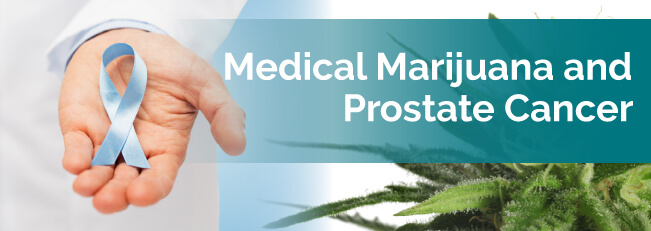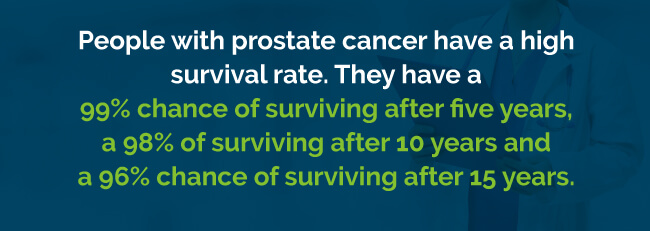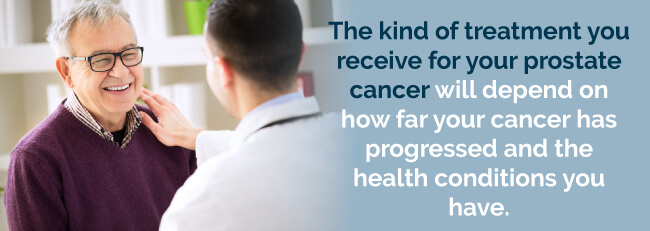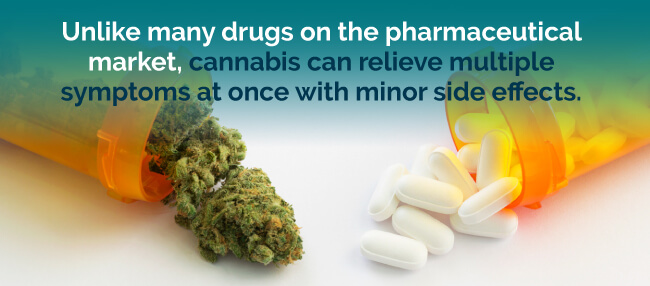
Cancer is one of the most talked-about diseases of our time. Science has dedicated itself to searching for a cure for as long as we’ve known about the disease. Our current treatments usually don’t guarantee a full cure and tend to put your body through a lot of stress.
It’s no wonder many cancer patients search for alternatives to the typical solutions doctors offer. While marijuana can’t completely replace your prostate cancer regimen, it can reduce your symptoms and possibly enhance your cancer treatment. Let’s examine how cannabis can aid you in the fight against prostate cancer.
The prostate is part of the male reproductive system. It is a small, round gland that is located in front of the rectum at the base of the bladder. Its primary function is to release fluid into the urethra during ejaculation. During ejaculation, sperm travels from the testicle through tubes called the vas deferens. The vas deferens run behind the bladder and enter into the prostate gland. During its journey, sperm combines with seminal fluids, other components of ejaculate, from three sources: the seminal vesicle, the prostate and the bulbourethral glands. The combined fluids called semen or ejaculate then travel the length of the urethra and out of the body via the penis. Prostate cancer develops as small nodules or bumps on the surface of the prostate which can be detected during rectal examination. There are many methods to treat prostate cancer. In most cases, the prostate does not need to be removed if the cancer is detected early. If prostate removal is necessary, the risk for erectile dysfunction increases because of the large number of nerves located near the prostate. Men over the age of 50 should have routine prostate cancer screenings as part of their regular health checkup; this includes digital rectal examination and serum PSA testing. Talk to your doctor about your individual risk for prostate cancer. Learn more below about how medical marijuana can help treat prostate cancer.
Some of the strongest, and most widely agreed-upon, clinical evidence regarding the use of medical marijuana is in the area of the treatment of cancer patients. Numerous clinical studies have shown the benefits offered by medical marijuana to cancer patients who are undergoing chemotherapy and/or radiation treatment.
Find A Doctor Find A Dispensary

Cannabidiol (CBD) is a compound found in medical marijuana. Clinical research has shown that CBD contains properties that relieve convulsion, inflammation, anxiety and nausea. It could even inhibit the growth of some cancer cells, including those that cause prostate cancer.
A chemotherapy patient needs to maintain a good diet to remain strong while the body fights off the cancer. Because chemotherapy can cause inflammation in the digestive tract, anything that helps reduce the inflammation will ultimately help the patient hold down food and remain healthy during the treatment.
Along with the anti-inflammatory benefits of medical marijuana, clinical studies have also repeatedly shown medical marijuana stimulates the appetite and reduces nausea, which can be critical for prostate cancer patients who are undergoing chemotherapy and/or radiation therapy.
Some studies have also found patients using medical marijuana suffer from less fatigue associated with radiation treatment, allowing the patient to live a more productive life while undergoing the treatment.
Finally, the relaxation benefits of medical marijuana have been shown to allow cancer patients to reduce stress levels, which, in turn, allows the body to better fight off the growth of the cancer cells.
Anandamide, a cannabinoid naturally created by our bodies, could work to kill and inhibit prostate cancer cells. Researchers investigated anandamide’s effect on isolated prostate cancer cells. To evaluate how much it impacted cancer cell levels and spread, they used a wide variety of evaluations, like staining and growth tests. The anandamide reduced receptors that communicate cell growth by activating the CB1 receptor. It also killed off a large number of cancer cells.
A review pointed out that cannabinoids could reduce some factors causing prostate cancer. Back in 1974, scientists found they lowered sperm production and testosterone levels in rats. In the early 1980s, researchers observed a decrease in substances like fructose and citric acid. The compounds examined in this study are all regulated by testosterone levels, and the results implied cannabis could reduce hormones that cause and exacerbate prostate cancer.
Another study examined the effects of non-THC cannabinoids on both isolated prostate cancer cells and prostate cancer cells in living beings. Researchers administered CBD and other compounds to test-tube cells and rats with tumors, and the cannabinoid worked incredibly well to kill the cells or reduce their spread. Also, an extract containing primarily CBD made some anticancer substances more effective.
We don’t have a simple answer for the question, “Which form of marijuana use will work best for my prostate cancer?” Only you and your doctor can decide the best route to take. However, we can give you some basic information about the many ways to use cannabis to give you the foundation you need to have this conversation with your oncologist.
The most frequently used methods of marijuana use include:
If you’re unsure about using a different method, consult with an expert like your doctor or dispensary staff. The kind folks working at your dispensary receive training that gives them the expertise to recommend products based on their effects and medical benefits.
Unlike mass-produced medicine you find in a pharmacy, marijuana doesn’t have black-and-white benefits and side effects. This is because patients and natural medicine practitioners define the side effects themselves. What helps one patient can be an inconvenience for another.
In other words, some of the common “side effects” of weed will actually help you out. Some side effects that benefit cancer patients include:
On the other hand, some cannabis side effects will function for you as just that — side effects. Not to worry! Most of them have easy fixes.
If you experience health problems you didn’t have before using cannabis medication, get in touch with your doctor right away. You could have an allergy you don’t know about, or you’re exacerbating another health issue that hasn’t been diagnosed.
The most important part of the medical marijuana experience is doing your research. As a one-stop source for your weed information, we offer numerous resources.
Getting started with the medical marijuana process requires basic knowledge about local resources and state laws. Read more about the cannabis laws in your state, the specially trained marijuana doctors in your area and the dispensaries supplying patients like you with quality medicine.
Once you have the basics down, you might want to dig deeper. For more condition pages like this guide, check out our list of conditions that qualify for medical marijuana. If you’d like to read about lesser-known topics surrounding cannabis and stay up to date, our blog features posts about recipes, legislature and more.
Find A Doctor Find A Dispensary
Cancer occurs when your body’s natural cell growth spirals out of control. The cells in the affected area begin to grow unchecked without dying off, crowding out healthy cells. When you have these extra cancer cells, your body has a harder time functioning.
Since cancers are named after the first location they manifest, prostate cancer is cancer that begins the gland found in men located right below the bladder. It produces part of the fluid contained in semen, and the urethra, or tube that urine travels through, goes through its center.
While prostate cancer begins in the prostate, if it gets to an advanced stage, it can spread to other parts of the body, causing symptoms in those areas. For instance, it can migrate to bone marrow, causing severe and chronic pain. Or, it can reach the spinal cord, interfering with mobility, bladder function and bowel movements.
Fortunately, prostate cancer has an incredibly low mortality rate and sometimes doesn’t even bother the person experiencing it. Many times, another health problem or old age will kill a patient before prostate cancer does. This is due to the fact that many cases of prostate cancer grow slowly.
Patients with early prostate cancer typically don’t experience any symptoms. However, in more advanced stages, they can have symptoms like:
In addition to the symptoms associated with prostate cancer, prostate cancer patients deal with symptoms caused by any type of cancer. Cancer symptoms have the potential to severely impact daily functioning and quality of life. General cancer symptoms include:


Catching prostate cancer early is vital to ensuring higher survivability and a smoother recovery. However, since prostate cancer usually develops very slowly, getting further testing isn’t always the best decision. Sometimes the cancer won’t grow large enough to be a threat before a man dies from a different cause.
The current unreliability of prostate cancer screenings compounds the issue further. For example, imagine an older man in poor health gets a false-positive result and goes through a prostate biopsy. If the biopsy puts him through a lot of stress, the treatment could actually harm his health rather than improve it.
However, this doesn’t mean that you should completely avoid prostate cancer screening — it’s just a more complicated situation than you may think. To make an informed decision about getting checked, talk with your doctor.
Doctors use two methods for primary prostate cancer screening on undiagnosed patients. They can test for prostate-specific antigens in the patient’s blood. Or, they can conduct a digital rectal exam, in which the doctor feels the prostate gland for abnormalities.
If the initial tests suggest the presence of prostate cancer, the physician will conduct further testing. A transrectal ultrasound allows your doctor to examine your prostate without using invasive surgery. In a biopsy procedure, a urologist will take samples of your prostate to inspect for cancer cells.
The kind of treatment you receive for your prostate cancer will depend on how far your cancer has progressed and the health conditions you have. Sometimes, you will just need to regularly check in with your doctor to track the progression of your cancer. In more advanced cases, you may have to go through surgery or other procedures tough on the body.

Two of the most well-known ways to treat cancer are chemotherapy and radiation therapy. While they’re two of the most effective treatment options we currently have, they can put your body under a lot of strain.
For prostate cancer patients who undergo chemotherapy and/or radiation therapy, the side effects of the therapy can be life-altering. Cancer cells divide rapidly, resulting in the spread of the disease throughout the body if not treated. Chemotherapy treats the patient with drugs that kill quickly dividing cells.
The idea behind chemotherapy is that the drug cocktail delivered will kill the cancer cells. Unfortunately, those same drugs do not differentiate between “good” cells and “bad” cells, resulting in the death of other rapidly dividing cells within the body as well. Along with killing the cancer cells, chemotherapy often kills cells within the digestive tract, bone marrow and hair follicles.
One of the most common side effects of chemotherapy is the inflammation of the digestive tract, leaving the patient unable to keep down food. Medical marijuana works to counteract this unwanted side effect by stimulating the appetite and reducing nausea and vomiting that often accompanies chemotherapy.
Radiation therapy, which is frequently used in conjunction with chemotherapy, uses strong beams of energy targeted at the cancer cells in an attempt to kill the lethal cells, or prevent them from dividing and multiplying. Radiation therapy, just like chemotherapy, can come with some extremely negative side effects, such as fatigue, nausea, sexual changes and diarrhea. Medical marijuana may be able to help counteract all these side effects, as well.
The drawbacks of typical cancer treatments are one of the reasons why we look into the benefits of consuming medical cannabis for prostate cancer. As we learn more about marijuana and prostate cancer, we can use this helpful drug to partially replace or supplement these treatments.
But marijuana’s cancer-fighting qualities don’t mean that you should completely dismiss your standard cancer regimen. The procedures we use are currently our best bet despite the risks, and not every patient has an adverse reaction to cancer therapies. Make sure to talk with your doctor before trying any alternative treatment methods yourself.
Unlike many drugs on the pharmaceutical market, cannabis can relieve multiple symptoms at once with minor side effects. While it cannot help with problems related to the urethra, such as difficulty urinating, it serves as an excellent supplement to cancer treatment by reducing cancer symptoms and side effects from treatment. Here are the ways that medical marijuana can help you as a cancer patient:

A potentially groundbreaking benefit of medical marijuana we’re still researching is its ability to kill cancer cells and keep them from spreading. While there’s not enough evidence to suggest cannabis can fully replace current treatments, the knowledge we have can teach us about the components of a successful cancer cure. Combined with its painkilling abilities, cannabis could work as the cancer medication hiding right under our noses.